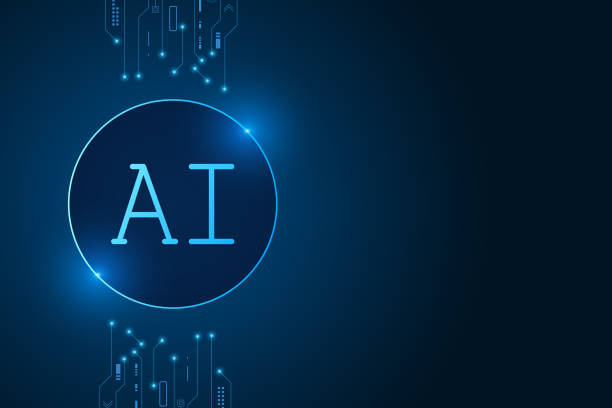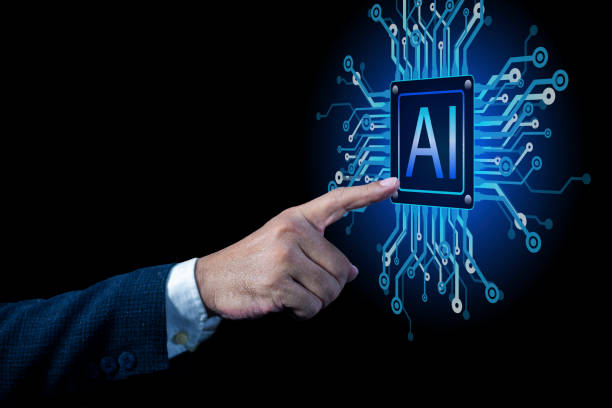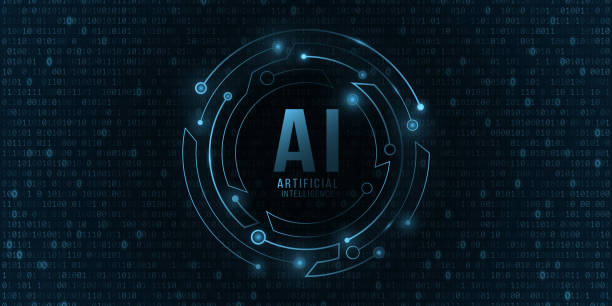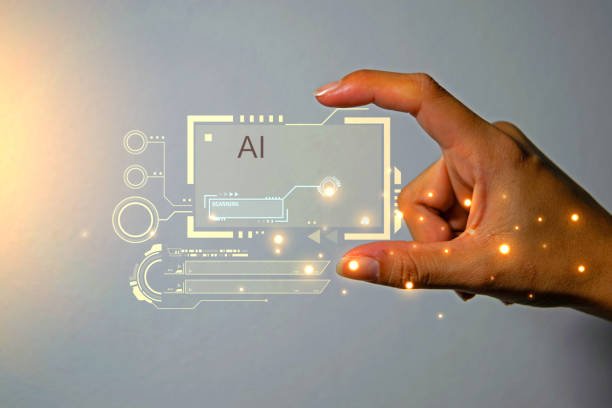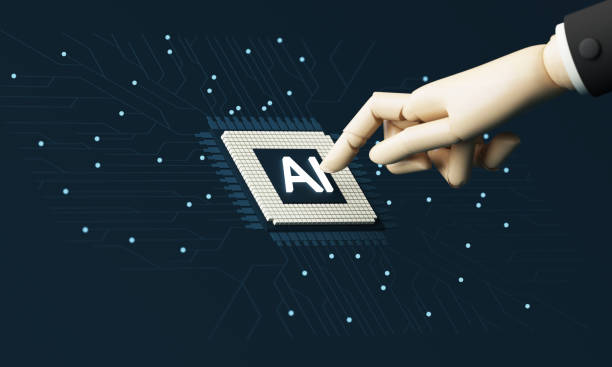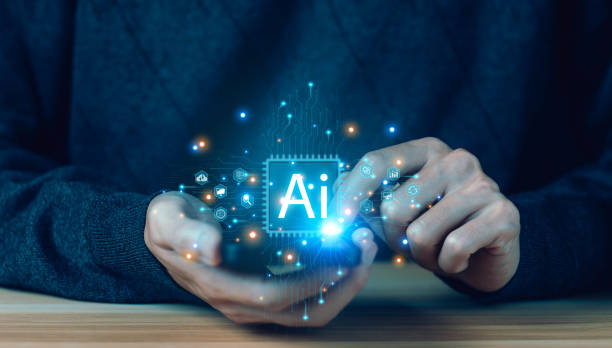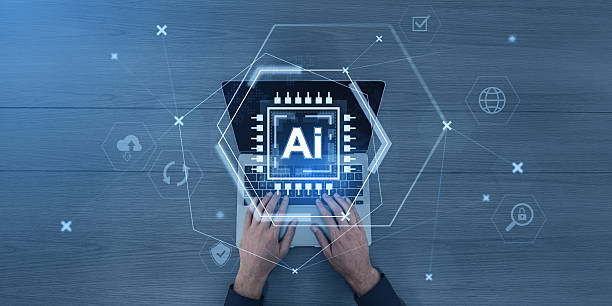What is Artificial Intelligence and How Does It Work?
What is Artificial Intelligence and How Does It Work?
Artificial intelligence (#AI) is a branch of computer science that deals with creating systems that can perform tasks that typically require human intelligence.
These tasks include learning, reasoning, problem-solving, understanding natural language, and pattern recognition.
Artificial intelligence strives to enable machines to think, learn, and act like humans.
AI systems analyze data using algorithms and complex mathematical models, and use them to make decisions or predictions.
In general, artificial intelligence identifies patterns based on input data and makes decisions using these patterns.
For example, a face recognition system learns face patterns using image data and can then identify new faces.
Machine Learning is one of the most important sub-branches of artificial intelligence that allows machines to learn from data without explicit programming.
There are various methods for implementing artificial intelligence, including deep neural networks, genetic algorithms, and rule-based systems.
Each of these methods is more suitable for specific applications.
For example, deep neural networks have been very successful in image recognition and natural language processing.
Are you worried about the low conversion rate of your online store and not having the sales you want?
Rasaweb is your specialized solution for having a successful online store.
✅ Significant increase in conversion rate and sales
✅ Professional and user-friendly design to attract customer satisfaction
⚡ Ready for a transformation in online sales? Get a free consultation!
Types of Artificial Intelligence: An Overview of Different Approaches
Types of Artificial Intelligence: An Overview of Different Approaches
Artificial intelligence can be divided into several categories based on its capabilities and functions.
One of the most common classifications is dividing it into Narrow AI, General AI, and Super AI.
Narrow AI is limited to performing a specific task, such as playing chess or recognizing faces.
Most of the AI systems that exist today fall into this category.
General AI has the ability to perform any task that a human can perform.
This type of AI is still under development and has not been fully realized.
Super AI surpasses human intelligence and can perform tasks that humans are unable to do.
This type of AI is still a hypothetical concept and does not exist.
Click here to preview your posts with PRO themes ››
In addition, artificial intelligence can be categorized based on the approaches used in its development.
Some of the common approaches include:
- Machine Learning
- Deep Learning
- Natural Language Processing
- Computer Vision
- Robotics
Each of these approaches has its own tools and techniques and is used to solve various problems.
For example, natural language processing is used to understand and generate human language, while computer vision is used to understand and analyze images.
Applications of Artificial Intelligence in Various Industries
Applications of Artificial Intelligence in Various Industries
Artificial intelligence has applications in various industries and is constantly expanding.
In the healthcare industry, artificial intelligence is used to diagnose diseases, develop drugs, and provide personalized care.
For example, AI systems can analyze medical images such as radiographs and MRIs and diagnose diseases with greater accuracy.
In the financial industry, artificial intelligence is used to detect fraud, manage risk, and provide financial advisory services.
AI algorithms can identify suspicious patterns in financial transactions and prevent fraud from occurring.
In the transportation industry, artificial intelligence is used to develop self-driving cars, optimize routes, and manage traffic.
Self-driving cars use sensors and AI algorithms to understand their surroundings and move without human intervention.
In the retail industry, artificial intelligence is used to personalize the customer shopping experience, predict demand, and optimize the supply chain.
AI systems can analyze customers’ tastes and needs and suggest suitable products and services to them.
In the education industry, artificial intelligence is used to provide personalized education, assess student performance, and provide immediate feedback.
AI systems can identify students’ strengths and weaknesses and design appropriate educational programs for them.
| Industry | Application |
|---|---|
| Healthcare | Disease diagnosis, drug development |
| Finance | Fraud detection, risk management |
| Transportation | Self-driving cars, route optimization |
Challenges and Limitations of Artificial Intelligence
Challenges and Limitations of Artificial Intelligence
Despite its many potentials, artificial intelligence faces challenges and limitations.
One of the most important challenges is the lack of training data.
AI systems need a lot of data to learn and improve their performance.
In some areas, it is difficult to collect sufficient and high-quality data.
Another challenge is bias in the data.
If the training data contains bias, AI systems will also be biased.
For example, if a face recognition system is trained using face data that mostly belongs to white men, it may perform poorly in recognizing the faces of women or non-white people.
In addition, explainability is one of the important challenges in artificial intelligence.
In many cases, the way AI systems make decisions is not clear.
This can lead to users’ distrust of these systems.
Also, ethical issues related to artificial intelligence are important.
For example, the use of artificial intelligence in autonomous weapons has raised many concerns.
Hardware limitations are another challenge of artificial intelligence.
Training and running complex AI models requires a lot of computing resources.
Finally, one of the biggest challenges is concerns about the replacement of human jobs with artificial intelligence.
With the advancement of artificial intelligence, many tasks that were previously performed by humans are now performed by machines.
This can lead to job loss and increased economic inequality.
To address these challenges, there is a need to develop new policies and training programs that help people acquire the skills needed to work in the world of artificial intelligence.
Does your current website convert visitors into customers, or does it scare them away? Solve this problem forever with professional corporate website design by Rasaweb!
✅ Building strong credibility and branding
✅ Attracting target customers and increasing sales
⚡ Get a free consultation right now!
The Future of Artificial Intelligence: Prospects and Possibilities
The Future of Artificial Intelligence: Prospects and Possibilities
The future of artificial intelligence is full of prospects and possibilities.
It is predicted that in the coming years, artificial intelligence will create tremendous transformations in various industries.
In the field of healthcare, artificial intelligence can help in early diagnosis of diseases, providing personalized treatments, and reducing healthcare costs.
In the field of education, artificial intelligence can help in providing personalized education, improving the quality of learning, and reducing educational inequality.
In the field of transportation, artificial intelligence can help in the development of self-driving cars, reducing accidents, and improving the efficiency of transportation systems.
One of the most important developments in the future of artificial intelligence is the development of general artificial intelligence.
If general artificial intelligence is realized, machines will be able to perform any task that a human can perform.
This can have profound consequences for society.
On the one hand, general artificial intelligence can help solve many global problems such as climate change, poverty, and disease.
On the other hand, general artificial intelligence can be a threat to human survival if not properly controlled.
In addition, it is expected that artificial intelligence will play a more prominent role in our daily lives.
AI systems will be present in our homes, workplaces, and vehicles and will help us perform various tasks.
For example, AI systems can make our homes smarter and optimize energy consumption.
They can also help us perform work tasks and increase productivity.
Machine Learning and Deep Learning: Differences and Similarities
Machine Learning and Deep Learning: Differences and Similarities
Machine Learning and Deep Learning are two related but different concepts in the field of artificial intelligence.
Machine learning is a general approach to developing systems that can learn from data and improve their performance without explicit programming.
Deep learning is a subset of machine learning that uses deep neural networks to learn from data.
Deep neural networks are complex mathematical models inspired by the structure of the human brain.
One of the main differences between machine learning and deep learning is the need for Feature Engineering.
In machine learning, it is usually necessary for important features of the data to be extracted and selected by humans.
This process can be time-consuming and costly.
In deep learning, deep neural networks can automatically learn the important features of the data.
This makes deep learning more suitable for problems with complex and unstructured data.
Another difference between machine learning and deep learning is the amount of data required for training.
Deep learning requires a lot of data for training.
The more training data there is, the better the performance of deep neural networks will be.
Machine learning can perform well with less data.
The main similarity between machine learning and deep learning is that both approaches use algorithms to learn from data.
These algorithms can be used to solve various problems such as classification, regression, and clustering.
Natural Language Processing: Key to Machine-Human Communication
Natural Language Processing: Key to Machine-Human Communication
Natural Language Processing (NLP) is an important branch of artificial intelligence that enables machines to understand, interpret, and generate human language.
NLP acts as a bridge between humans and computers, allowing machines to communicate with humans in a language that is understandable to them.
This field includes a wide range of tasks, including machine translation, sentiment analysis, text summarization, question answering, and text generation.
Machine translation is an important application of NLP that allows machines to translate text from one language to another.
Sentiment analysis allows machines to detect emotions in text.
This capability is used in various fields such as marketing, customer service, and social media monitoring.
Text summarization allows machines to generate a summary of a long text.
This capability is used in fields such as news gathering and document analysis.
Question answering allows machines to answer questions asked in natural language.
This capability is used in customer support systems and search engines.
Text generation allows machines to generate new text in natural language.
This capability is used in fields such as content generation and chatbots.
| Application | Description |
|---|---|
| Machine Translation | Automatic translation of text from one language to another |
| Sentiment Analysis | Detecting emotions in text |
| Text Summarization | Generating a summary of a long text |
| Question Answering | Answering questions asked in natural language |
NLP processes human language using various algorithms such as neural networks, language models, and rule-based algorithms.
With the advancement of artificial intelligence, NLP is constantly improving and new applications are being discovered for it.
Computer Vision: How Computers See the World
Computer Vision: How Computers See the World
Computer Vision is another important branch of artificial intelligence that enables computers to understand and interpret images and videos.
Computer vision allows computers to “see” and “understand” the world around them, just like humans.
This field includes a wide range of tasks, including object detection, face recognition, motion detection, medical image analysis, and autonomous driving.
Object detection is one of the main tasks of computer vision that allows computers to detect different objects in images.
This capability is used in various fields such as robotics, self-driving cars, and surveillance systems.
Face recognition allows computers to detect people’s faces in images and videos.
This capability is used in security systems, social networks, and user identification.
Motion detection allows computers to detect the movement of objects in videos.
This capability is used in surveillance systems, video games, and the detection of unusual activities.
Medical image analysis allows computers to analyze medical images such as radiographs and MRIs and diagnose diseases.
This capability helps in the early diagnosis of diseases and providing personalized treatments.
Autonomous driving allows computers to drive cars without human intervention.
This capability helps in reducing accidents and improving the efficiency of transportation systems.
Computer vision processes images and videos using various algorithms such as neural networks, deep learning algorithms, and feature-based algorithms.
With the advancement of artificial intelligence, computer vision is constantly improving and new applications are being discovered for it.
Are you lagging behind in competition with large online stores?
Rasaweb will take your business online and increase your market share with professional online store design!
✅ Increased brand credibility and customer trust
✅ Easy shopping experience leading to more sales
⚡ Act now to get a free website design consultation!
Robotics: Combining Artificial Intelligence and the Physical World
Robotics: Combining Artificial Intelligence and the Physical World
Robotics is a multidisciplinary field that combines artificial intelligence with mechanical engineering, electrical engineering, and computer science to design, build, operate, and use intelligent machines (robots).
Robots can perform tasks that are dangerous, repetitive, or difficult for humans.
Robotics is widely used in various industries such as manufacturing, healthcare, space exploration, and services.
In the manufacturing industry, robots are used to perform tasks such as welding, painting, assembly, and packaging.
Robots can perform these tasks faster and more accurately than humans.
In healthcare, robots are used to perform tasks such as surgery, rehabilitation, and drug delivery.
Robots can perform complex surgeries with greater accuracy and help patients in rehabilitation.
In space exploration, robots are used to perform tasks such as collecting samples, examining the environment, and repairing equipment.
Robots can access places that are dangerous or impossible for humans.
In services, robots are used to perform tasks such as cleaning, delivering goods, and providing customer service.
Robots can provide services faster and more efficiently.
Artificial intelligence plays an important role in robotics.
Artificial intelligence allows robots to understand their surroundings, make decisions, and perform their tasks independently.
With the advancement of artificial intelligence, robots are becoming smarter and more capable and can perform more complex tasks.
Ethical Issues of Artificial Intelligence: Challenges and Responsibilities
Ethical Issues of Artificial Intelligence: Challenges and Responsibilities
The development and use of artificial intelligence is accompanied by important ethical issues that require careful attention and consideration.
One of the most important ethical issues is bias in algorithms.
If the training data used to train AI systems contains bias, these systems will also be biased.
For example, if a recruitment system is trained using historical data showing that men are more likely than women to be hired for management positions, the system may subconsciously prefer men to women.
Another issue is privacy.
AI systems are used to collect and process people’s personal data.
This data may include sensitive information such as medical records, financial information, and information about people’s online behavior.
To protect people’s privacy, there should be strict laws and regulations regarding the collection, use, and sharing of this data.
Accountability and transparency are also important ethical issues in artificial intelligence.
If an AI system makes a decision that results in harm, who is responsible? How can we ensure that AI systems operate fairly and transparently?
In addition, there are concerns about the replacement of human jobs with artificial intelligence.
With the advancement of artificial intelligence, many tasks that were previously performed by humans are now performed by machines.
This can lead to job loss and increased economic inequality.
To address these challenges, there is a need to develop new policies and training programs that help people acquire the skills needed to work in the world of artificial intelligence.
Finally, to ensure that artificial intelligence benefits society, there is a need for cooperation between scientists, policymakers, industry leaders, and the general public.
Artificial intelligence must be developed and used in a way that preserves human values and helps improve the quality of human life. Artificial intelligence and data science
FAQ
| Question | Answer |
|---|---|
| What is artificial intelligence? | It is the simulation of human intelligence in programmed machines to think like humans and mimic their actions. |
| What are the main branches of artificial intelligence? | They include machine learning, deep learning, natural language processing, computer vision, and robotics. |
| What is Machine Learning? | It is a branch of artificial intelligence that focuses on enabling systems to learn from data and identify patterns without explicit programming. |
| Mention examples of artificial intelligence applications in our daily lives. | Voice assistants (such as Siri and Alexa), recommendation systems in Netflix and Amazon, self-driving cars, and facial recognition software. |
| What is Deep Learning? | It is a subset of machine learning that uses multi-layered (deep) artificial neural networks to process large amounts of data. |
| What is Natural Language Processing (NLP)? | It is a branch of artificial intelligence that focuses on enabling computers to understand, interpret, and generate human language. |
| What are some of the ethical concerns related to artificial intelligence? | They include bias in the data, privacy, job losses, and liability in case of errors. |
| What are the main benefits of artificial intelligence? | Increased efficiency, improved decision-making, automation of repetitive tasks, and discovery of complex patterns in the data. |
| How is artificial intelligence used in the field of healthcare? | In disease diagnosis, drug discovery, analysis of medical images, and personalized care for patients. |
| How do you see the future of artificial intelligence? | It is expected to continue developing at a rapid pace, affecting all aspects of human life, from industry to education and entertainment. |
And other services of Rasa Web advertising agency in the field of advertising
Smart conversion rate optimization: A creative platform to improve sales growth with intelligent data analysis.
Smart Marketplace: Designed for businesses looking to increase click-through rates through precise audience targeting.
Smart brand identity: A creative platform to improve click-through rates by designing an attractive user interface.
Smart Website Development: An effective tool for user engagement through intelligent data analysis.
Smart Marketing Automation: A fast and efficient solution for customer acquisition with a focus on custom programming.
And over hundreds of other services in the field of internet advertising, advertising consulting and organizational solutions
Internet advertising | Advertising strategy | Advertising report
Sources
What is Artificial Intelligence and How Does it Work?
,Comprehensive and Introductory Guide to Artificial Intelligence: Everything You Need to Know
,What is Artificial Intelligence? — In Simple Terms
,What is Artificial Intelligence? From A to Z of AI
? Is your business ready to leap into the digital world? Rasa Web Digital Marketing Agency, with comprehensive and innovative solutions, paves the way for your success. From professional website design and SEO optimization to managing targeted advertising campaigns, we are with you every step of the way in your business growth.
📍 Tehran, Mirdamad Street, next to the Central Bank, South Kazerun Alley, Ramin Alley, No. 6

